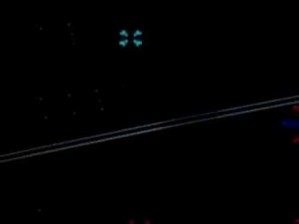
“A line for the pleasure of being a line, of going ahead, as a line. Points. Dust of points. A line is dreaming. Before then, no one had ever let a line dream.”
| This quote of H.Michaux from ‘Adventures of Lines’ (org. ‘Aventures de lignes’) opens Laura U.Marks essay ‘Taking a line for a walk, from the Abbasid Caliphate to computer graphics, or, The Performativity of the Vector’ – though she continues in regard of her ongoing research of Islamic art and calligraphy – The poet Michaux writes that never before Klee had a line been allowed to dream, to be a line for the pleasure of being a line. In fact the abstract line had been permitted to dream quite extravagantly long before it returned to European painting. |  L’Alphabet rouge (1994) by Mounir Fatmi, via ejumpcut |
.. and to give out another very nice example of this short publication as an invitation to read, I excerpt some lines where she draws on S.Cubitt’s characterization of the vector, which almost can be read as a postmodern definition of processual identity. … In vector graphics the line emanating from the center of the monitor is actually a moving point that leaves behind it a trail of light as it connects one point to another. Vector graphics are still used in oscilloscope and radar, those wonderfully analog screen-based media. Vector graphics can draw quickly in real time with very little data, making them ideal for early computer arcade games.
The line of vector graphics, which is drawn as a vector from the center of the screen, is actually a moving point that leaves behind it a trail of light as it connects one point to another. It exists as a momentary leap between programmed points. It doesn’t have independent existence. The living-dying line of vector graphics is taken up poetically by film scholar Sean Cubitt, who defines the vector generally as “any quantity that has magnitude and direction†and specifically as a line that describes not being but becoming, not identity but mobile relationship. ….
The entire article can be found online via Tributaries & Text-Fed Streams:A Feed-Reading of The Capliano Review, which is a performative work in itself by J. R. Carpenter and thus worth of being mentioned here, while I will re-publish Laura U.Marks essay in my section of her works on mindgap.org.
| In this work she explores the formal and functional properties of RSS, using blogging, tagging and other Web 2.0 tools to mark-up and interlink essays and to insert additional meta-layers of commentary in order to play with, expose, expand upon, and subvert formal structures of writing, literature, and literary criticism. | The Jupiter 2 Arcade presents a tribute to classic arcade vector graphics games. / nostalgia for Old School Arcade Games? |
|
Over a four-month period Carpenter read and re-read the essays, parsing them into fragments, which she then annotated, marked-up, tagged and posted. Fed into an RSS stream, the fragments could then be re-read, reordered, and reblogged in an iterative process of distribution that opened up new readings of the essays and revealed new interrelationships between them. The result of this process-based approach is part blog, part archive – an online repository for the artifacts of re-reading and a stage for the performance of live archiving. Streams are both literally and metaphorically the central image of the work. Streams of consciousness, data, and rivers flow through the interface and through the texts. Through this process of re-reading and responding, this textual tributary feeds into a larger stream while paying tribute to the original source. links: |
|
